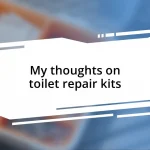Key takeaways:
- Understanding tank-to-bowl repairs begins with recognizing key components: bolts, gaskets, and flush valves, and the importance of regularly inspecting these parts to prevent leaks.
- Having the right tools—such as an adjustable wrench, screwdrivers, and a replacement gasket kit—can enhance confidence and ease during the repair process.
- Essential tips for successful repairs include turning off the water supply before starting, taking your time during disassembly, and testing for leaks after reassembly.
- Regular maintenance checks and awareness of the surrounding environment can prolong the effectiveness of repairs and prevent recurring issues.

Understanding tank-to-bowl repair basics
When I first encountered a tank-to-bowl leak, I felt a mix of frustration and confusion. Understanding the basics of this repair starts with recognizing that the toilet’s tank sits atop the bowl, connected by a few crucial components: bolts, a gasket, and sometimes a flush valve. Each part plays a vital role, and if one fails, it can lead to a mess—a thought that definitely made me pause.
I remember the moment I decided to tackle my own repair instead of calling a plumber. It was empowering! I discovered that the gasket, a rubber seal between the tank and bowl, is often the culprit when leaks arise. Checking this seal during maintenance not only prevents water waste but also ensures your toilet operates efficiently. Have you ever taken the time to inspect these seemingly small parts? You’d be surprised at the difference it can make in delaying bigger issues.
Replacing these components may seem daunting at first, but I found it quite manageable with the right tools and a bit of patience. The process involves draining the tank, unscrewing the old bolts, and carefully positioning the new gasket before reattaching the tank. It’s a step-by-step method, and each moment of progress left me feeling more knowledgeable and connected to my home. What’s more satisfying than solving a problem yourself?

Identifying common tank-to-bowl issues
Identifying common tank-to-bowl issues starts with keeping an eye on leaks, which can be a sole sign of several underlying problems. I remember the sinking feeling I had when water started pooling around the base of my toilet. It turned out that it was a loose bolt causing the tank to wobble, leading to the leak. A simple check on each bolt secured everything, and it was such a relief to see the water stop flowing!
Another frequent occurrence is the presence of cracks or damage in the tank itself. After an incident where I accidentally knocked the tank while cleaning, I learned the hard way that even minor impacts can lead to major cracks. Spotting these issues early can save you a headache and an expensive replacement down the line. Have you checked the integrity of your tank recently? A quick visual assessment can prevent future mishaps.
Additionally, the gasket can degrade over time due to age or exposure to harsh cleaning products. I’ve experienced that tell-tale smell of stagnant water, which alerted me to a failing gasket. The replacement process was surprisingly simple and significantly improved my toilet’s performance. Just a few minutes of preventive maintenance can go a long way in extending the life of your plumbing fixtures!
| Common Issue | Description |
|---|---|
| Leaks | Often caused by loose bolts or faulty gaskets, leading to water pooling around the toilet base. |
| Cracks | Damage from impacts can cause cracks in the tank, leading to significant leaks. |
| Degraded Gasket | Over time, gaskets can wear out, resulting in leaks and unpleasant odors. |

Tools needed for tank-to-bowl repair
When tackling a tank-to-bowl repair, having the right tools can make all the difference. I remember when I decided to handle my first repair—I thought I was underprepared and almost gave up. But once I gathered the necessary tools, everything fell into place. It’s amazing how a little organization can ease the tension of a DIY project.
Here’s a list of essential tools you’ll need for a successful tank-to-bowl repair:
- Adjustable wrench: Perfect for gripping and turning tricky nuts and bolts.
- Flathead screwdriver: Useful for prying and loosening stubborn components.
- Phillips screwdriver: Ideal for removing screws in different fixtures.
- A bucket or towels: Essential for catching any excess water during the repair.
- Replacement gasket kit: Ensure you have the right size and type for a secure seal.
I still remember the satisfaction I felt when the last bolt was tightened and there were no more leaks. It’s rewarding to learn and grow through these hands-on experiences, isn’t it?
Having the right tools isn’t just about convenience; it also creates a sense of confidence. The first time I tried this repair, I scrambled to find makeshift tools, which added to my anxiety. The next time, with my toolbox at the ready, I felt a surge of empowerment as I picked up each tool, knowing that I was fully equipped to tackle the challenge. Preparation really can transform an overwhelming task into a victorious project.

Tips for successful tank-to-bowl repairs
Every successful tank-to-bowl repair starts with shutting off the water supply first. I can’t stress enough how important this simple step is—during my first attempt, I neglected to do this and ended up in a small flood that was both messy and stressful. It took me a few laughs and some extra towels to clean up the chaos, but now I always double-check and turn off that valve before diving in!
Next, take your time when removing the tank; rushing can lead to mistakes. I vividly remember my impatience when I tried to hurriedly unscrew bolts, which led to stripped threads. That was a frustrating setback! Now, I’ve learned to tackle each bolt gently and patiently, ensuring that I don’t damage anything along the way. It’s one of those lessons that reinforce the value of being mindful and taking a breath before getting started.
Finally, always test for leaks after reassembling everything. I used to skip this step because I assumed everything was perfect after tightening. I learned the hard way when I walked away and heard that dreaded dripping sound soon after. Now, I run a quick test once my repair is done—nothing beats the peace of mind that comes from knowing all your hard work paid off! Have you ever skipped a vital final check in DIY? It’s disappointing, but it’s such a simple fix for your own confidence in the job done right.

Maintenance advice for long-lasting repairs
Maintaining the repairs you’ve made is crucial for longevity, and it’s something I learned the hard way. After my first successful tank-to-bowl fix, I was so proud that I forgot to give it a little TLC. A few weeks later, I noticed a slight leak again. I realized that regular checks can prevent small issues from turning into larger headaches down the road. Who wants to relive a repair just because they skipped a simple inspection?
Another aspect that deserves attention is the environment around the toilet. I’ve found that keeping the area clean and dry helps in preserving the integrity of the repair. After brushing the bathroom floor one day, I discovered a bit of humidity that could slowly affect the seals I had just installed. I found myself asking, “How can I ensure my hard work stands the test of time?” Making small changes in maintenance—like ensuring good ventilation—has made a noticeable difference.
Lastly, remember that products used in repairs also need proper care. I once used a sealant that promised to be super strong but didn’t pay close attention to its recommended drying time. As a result, my repair didn’t hold up as I had hoped. I now make it a point to read labels thoroughly; understanding product usage can save a lot of future frustration. It’s so simple yet significant—have you ever overlooked a detail and faced the consequences? It’s a reminder that every bit of knowledge counts in DIY projects!

Troubleshooting after tank-to-bowl repairs
After completing a tank-to-bowl repair, you might encounter unexpected issues. I remember the first time I was confident everything was perfect, only to find water pooling on the floor the next morning! It’s a gut-wrenching moment when you realize that perhaps a washer wasn’t seated correctly. Checking every connection thoroughly can save you from that sinking feeling, literally.
Another common troubleshooting step involves the flapper valve. I once thought I had it fixed, but the toilet kept running intermittently. After diving back in, I discovered that the chain was too short, causing the flapper to malfunction. It’s a little detail that packs a big punch—don’t underestimate how something so seemingly minor can affect the entire system. Have you ever faced a frustrating moment like that? It can be such a relief once you identify the culprit and make the adjustment!
Lastly, if your toilet is still making odd noises despite seemingly being in good shape, consider the water supply line. I experienced a high-pitched whine after my repair, which I later learned was due to air trapped in the line. I had to flush the line and check all connections. It made me realize that even the best repairs can have a trickle-down effect on other components. Don’t you wish every fix was as smooth as we hope? Just remember, one step back can lead you to a big leap forward in ensuring everything works harmoniously.














